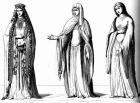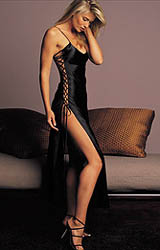Women's fashion still unable to connect image of sexiness and faithfulness
In thousands of years of its history, women's fashion has become the guarantee of procreation
Up-to-date women's fashion is said to follow the laws of sexual attraction, although nothing like that has been noticed during the latest decade. An average woman has always been smarter than an average man. Women are particularly more practical and ambitious. That is why fashion has been keeping up with social needs, including sexual needs. Politics can be described as concentrated economics. Women's fashion can be described as the concentrated incarnation of the public development. Therefore, women's fashion has become the procreation guarantee.
A woman's fur coat was all the vogue 30,000 years ago. The demand on beads and bracelets was registered 20,000 years ago. Skirts and ponchos became first garments that came into fashion – it happened in the VIII millennium B.C., in Jericho. Style-lovers of ancient times liked wearing beads and copper rings. Gold jewelry was brought into fashion a thousand years later.
In other words, women considered accomplishments of ancient science and technology quite sexy during the first 25,000 years of human civilization history. Approximately in the V millennium B.C., women started inventing fashionable things themselves, without anyone's help. First cosmetics appeared in Egypt during those years. Necklaces and neck bracelets appeared a thousand year afterwards. Women were wearing many big rings on their necks, trying to make them grow longer – a long neck was considered very attractive at that time.
 Middle Ages became the only black period in the history of women's fashion. Knights and priests made women wear chastity belts, which caused considerable hygienic damage to women's genitals. Women's breasts were clinched between special lead plates. Ladies were wearing grey overalls, which could hardly be referred to as dresses.
Middle Ages became the only black period in the history of women's fashion. Knights and priests made women wear chastity belts, which caused considerable hygienic damage to women's genitals. Women's breasts were clinched between special lead plates. Ladies were wearing grey overalls, which could hardly be referred to as dresses.
The Renaissance epoch liberated women, and they started ruling the world of fashion again. At first they used cut-outs on dresses to unveil the upper part of bosom. Then they invented underwear.
Men's shirt turned to women's night shirt in the XVIII century. In ten years it became a beautiful, silky and lacy intimate garment. Long underpants were shortened very quickly. Women's bathing suit appeared in the XIX century.
 Elegant erotic outfits became rather helpful in people's private lives too. Writers started writing love novels, painters started making passionate paintings. Men started adjusting their businesses to women's fashion. The clothes were becoming sexier: women started wearing hoop-like frameworks underneath their dresses. Corsets took the form of a sand-glass: big breasts, narrow waist and broad hips. Corsets became quite dangerous for internal organs – they were extremely tight.
Elegant erotic outfits became rather helpful in people's private lives too. Writers started writing love novels, painters started making passionate paintings. Men started adjusting their businesses to women's fashion. The clothes were becoming sexier: women started wearing hoop-like frameworks underneath their dresses. Corsets took the form of a sand-glass: big breasts, narrow waist and broad hips. Corsets became quite dangerous for internal organs – they were extremely tight.
Women decided that the white color of clothes would mean innocence, red clothes would suggest passion, and black clothes would imply sin. Spontaneity was later colored in blue, stability was marked in clothes in yellow color, the well-being was considered to be beige-colored, and the brown color was used to emphasize ambition and determination.
The great 'cosmetic revolution'' occurred in the beginning of the XX century. Apparently, it will last for a very long time in the future too. Women started using and perfecting powder to make their skin look fresh and young. Mascara made women's eyes look more beautiful and more desirable for men. However, lips became the most important target of the 'cosmetic revolution,' which eventually ended up in the boom of the lipstick-making business.
Scientists believe that woman's lips are very reminiscent of female genitals. There has been a special medical term invented to designate such a similarity – the genital echo. Women of ancient Egypt used only red lipstick, which is definitely only a meager part of what is available on the present-day market of cosmetics: hundreds of sophisticated shades, moisturizing and long-lasting, lightweight and silky lipsticks, and so on and so forth.
The contemporary women's fashion, however, has not solved the most important question yet: how to connect a sensual image of a woman, which provokes men to strive for intimacy, with an image of a respectable lady, who could be a good wife or a good employee?
It may seem to be ridiculous, but warriors and dictators unintentionally pushed the development of synthetic fashion. Hitler and the sexy SS uniform launched the new style of color combination: white and black, black and yellow. Bellicose Caucasians  dressed their women in huge fur hats and cavalry boots. To crown it all, women conceived the eroticism of high leather boots and stylish leather bags in Stalin's era.
dressed their women in huge fur hats and cavalry boots. To crown it all, women conceived the eroticism of high leather boots and stylish leather bags in Stalin's era.
The military style is considered the last word of present-day fashion with its beige, green, brown and khaki colors. Ties and scarves are very fashionable too, along with strict jackets and short skirts. Fashion has become aggressively sexy, although one may not doubt that women and time will make considerable corrections to it.
Aleksey Perfiliev
Subscribe to Pravda.Ru Telegram channel, Facebook, RSS!




